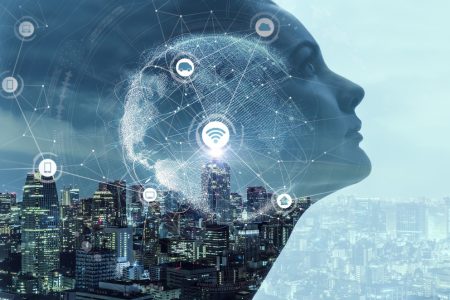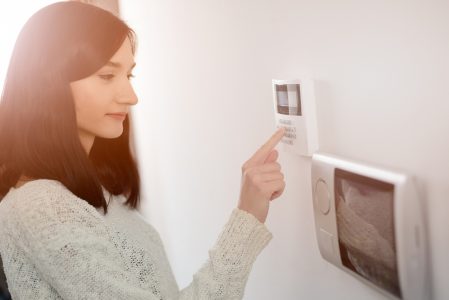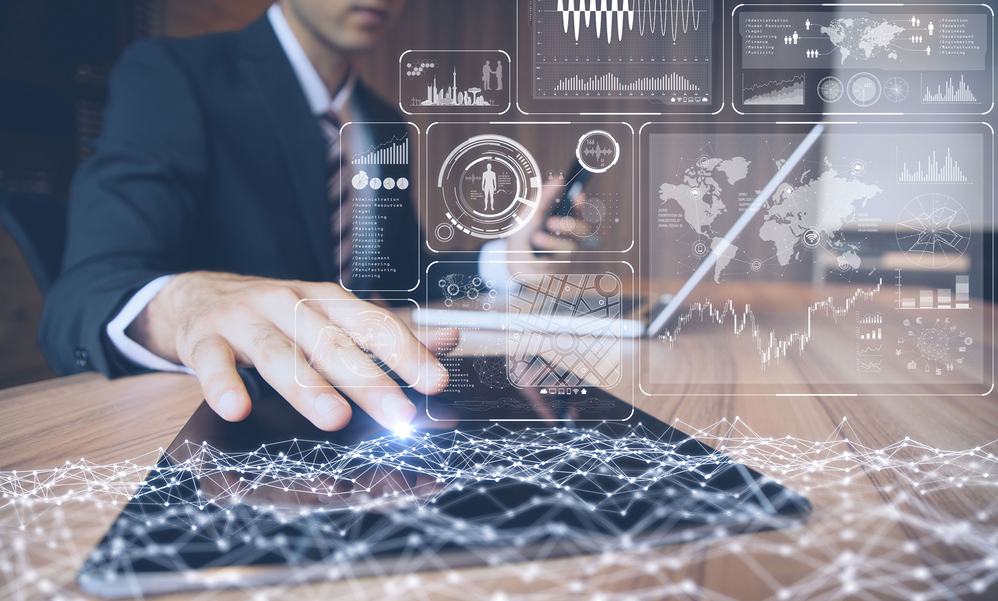A building’s mirror image
Issue :
read all articles online
read as pdf
It is already a well-established concept in manufacturing: the digital twin, a virtual map of a machine across its entire life cycle. The goal is to make production much more efficient, more flexible and more individualized. Digitalization is also making rapid strides forward in buildings. The Internet of Things (IoT) facilitates a digital twin of a building, which maps the exact usage requirements in the virtual world. This leads to automated service processes in facility management, greater energy savings and a more personalized sense of wellbeing on the part of the users. The solutions range from basic smart home configurations to ambient assisted living to complex networks of disciplines in office buildings. There is one thing that all these applications cannot do without: the self-powered wireless sensor.
According to the study titled “Unternehmenstrends 2020” (Company Trends 2020) published by the GdW*, tenants will be in direct digital communication with property management companies in the future. Digitally collected building data allows operators to monitor technical installations in real time and carry out necessary work just as quickly. At the same time, they can offer their tenants services that help save them money – in terms of energy consumption, for instance. To this are added intelligent systems that improve individual comfort in the apartments.
From the elevator to the apartment
In retrofit and new construction projects alike, more and more property management companies are already establishing the basis for digital functions in their buildings. Since all automation systems run on bits and bytes, it all begins with a seemingly mundane aspect: an Internet access – not only in the apartments but also in the areas of general use. With this step, automation initially starts outside the apartments, for example with the aid of wireless sensors that signal necessary maintenance and repair work on elevators, heating and air-conditioning systems or other technical installations. Digital door access systems or doorbell displays are also possible. An IoT gateway transmits the sensor data to the service provider’s system via the Internet. This enables the service provider to operate the building much more efficiently, more service-oriented and using less energy.
Smart home products and services in apartments rely primarily on user acceptance. A wide range of technical capabilities are available in smart homes today. However, residents should not feel as though the technology runs their lives but instead have functions that operate behind the scenes or give them the ability to deliberately select the ones that meet their individual demands. A basic package can establish the technical requirements for smart control. Along with the Internet access, this includes primarily the blind control function. Tenants can use this function to raise and lower the blinds at the press of a button. At the same time, window contacts signal whether a window is open. Another application is a central “all on/all off” button that can be used to turn off electronic devices, such as the lights, when leaving the apartment and to turn everything back on again when the resident returns.

Smart home on demand
A fundamental network is thus already available, which can form the basis for additional smart home functions. Property managers can offer their tenants different options, such as heating control or multimedia via voice control. They can also use test installations to recommend the technical equipment and available systems. As a result, the users do not have to personally deal with the different smart home packages available on the market. This is another important service that property management companies can offer to make their properties more attractive and valuable to tenants.
At the same time, companies can use smart technology to offer entirely new, automated services, for example in the form of flat-rate power supply or billing according to room temperature level per square meter of heated space**. A kind of contracting model is also conceivable. In this case, service providers make the desired smart home infrastructure available in different packages and refinance their investment, for example through the energy savings achieved. Residents benefit from greater security and comfort.
Invisible everyday assistants
These two criteria, in particular, are important for ambient assisted living packages. In this form of building digitalization, the basic package must already include important functions, including motion sensors in rooms and mattresses as well as fall and presence sensors or flexibly positioned emergency call and operating buttons. The sensors supply the necessary information and thus become indispensable everyday helpers for senior citizens. At the same time, vital signs or sensors that detect wellbeing and activity can be optionally integrated. They significantly increase the residents’ independence, since they provide support only when specifically needed. Operators of apartments suitable for seniors can include various smart home functionalities in the rent as part of a service package.

Focus on rooms
The most frequent applications of a building’s digital twin are currently in office complexes. Digitalization with the aid of distributed sensors and a cloud-based infrastructure enables facility managers to develop and automate new services. This includes, for example, room use management. Presence sensors can detect at all times how many people use a conference room and how often or when the cafeteria is especially crowded. Room occupancy and thus the use of cost-intensive resources, such as heating, air-conditioning and lights as well as staff and inventory, can be optimized based on usage data.
Detailed usage patterns of the building, staff and inventory can be prepared with the aid of sensor data collected by additional sensors such as door contacts, activity meters in electronic devices, etc. These patterns supply real-time information about the actual demand and allow appropriate measures to be taken to make services more efficient, energy-saving and dependent on the situation. Another example is the usage-dependent maintenance and cleaning of sanitary facilities in office buildings. Sensors supply the necessary data, such as how often the rest rooms are used or whether the toilet paper, towel and soap dispensers are running low on stock. Facility managers can use this data to organize their staff according to current requirements and always restock needed materials on time. This not only lowers costs but also increases user satisfaction.

A comfortable environment
Greater user satisfaction also makes companies more attractive as landlords of office space. A comfortable atmosphere at the office has been proven to improve work productivity and to promote employee loyalty. Integrated sensors in office furniture make it possible to design the furnishings colorfully and individually according to requirements and simultaneously equip the offices, for example, with state-of-the-art multimedia and smart light and heating control. Because of hidden sensors, employees are unaware of the IoT technology and notice primarily the comfort factor.
 The list of optimized processes in a digitalized building is practically endless. For example, it can include sensors that sound the alarm if a water mains ruptures or in the event of a fire or break-in and thus prevent millions in insurance losses.
The list of optimized processes in a digitalized building is practically endless. For example, it can include sensors that sound the alarm if a water mains ruptures or in the event of a fire or break-in and thus prevent millions in insurance losses.
Flexible wireless technology
However, more than 90% of buildings are existing real estate. Wireless solutions must therefore be considered for adding a comprehensive digital infrastructure. This is the only way to establish the right cost-benefit ratio. Wireless sensors, which supply the necessary data from numerous points within the building, always form the technological foundation. In particular, the EnOcean wireless standard has become established as the communication protocol. It is used in more than 500,000 buildings around the world. Thanks to mesh technology, however, Bluetooth® and Zigbee can also be used for specific applications. An IoT gateway interconnects the sensors and actuators over the Internet with cloud-based platforms such as IBM Watson, Amazon Echo, Microsoft Azure, Apple HomeKit, Google Home and Crestron.
Self-powered IoT
This Internet of Things, with its thousands of data points within a building, can be implemented only with self-powered wireless sensors. They can be placed freely and flexibly and added to at any time — above all, without requiring any maintenance. Batteries have served out their purpose in the IoT as a source of energy for sensors. A sample calculation makes this clear: radio-based heating valve radiators operate on two batteries, which have a service life of approximately one year. In an office complex with 10,000 wireless components installed, the facility managers would have to replace around 30 batteries per day. In addition, early failures ensure that the maintenance work must begin shortly after installation. Once the first battery has failed within the service life, the building operator will have to replace all batteries as a precaution. This requires an incalculable amount of labor and correspondingly high costs that are not incurred with self-powered wireless components.
Environmental responsibility is another consideration. Mountains of toxic battery waste should not be the price we pay for greater energy efficiency and wellbeing in our buildings.
* GdW Bundesverband deutscher Wohnungs- und Immobilienunternehmen e. V. (Federal Association of German Housing and Real Estate Enterprise Registered Associations): “GdW Industry Report 5 – Company Trends 2020“
** MPW Consulting: “MPW Study: Energy Services in The Property Management Business“, 2017
New articles in Smart Spaces
Top articles





